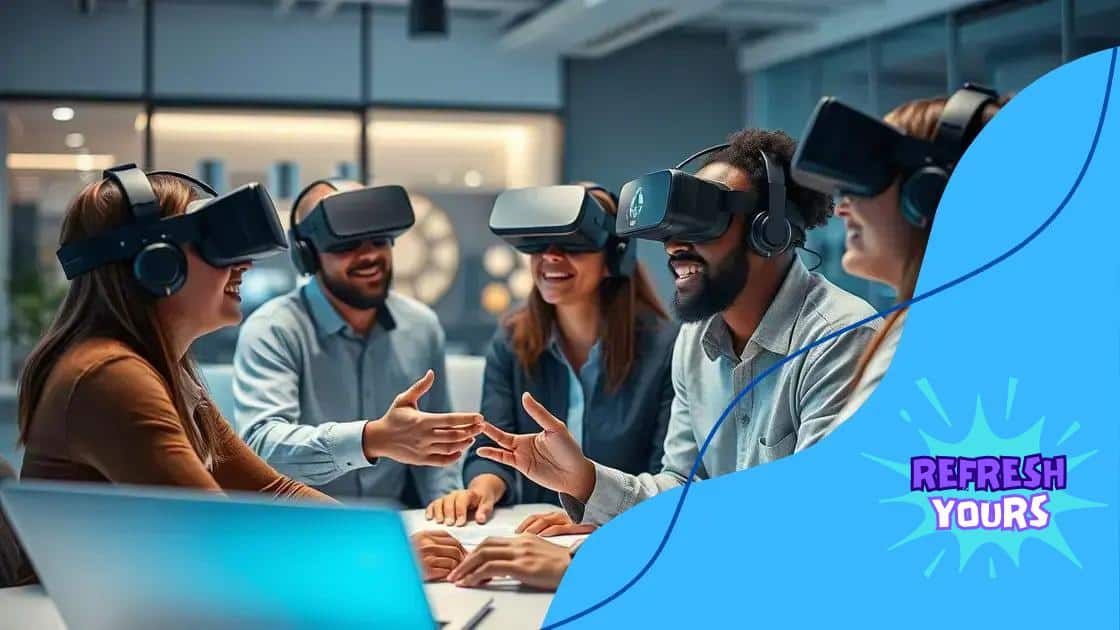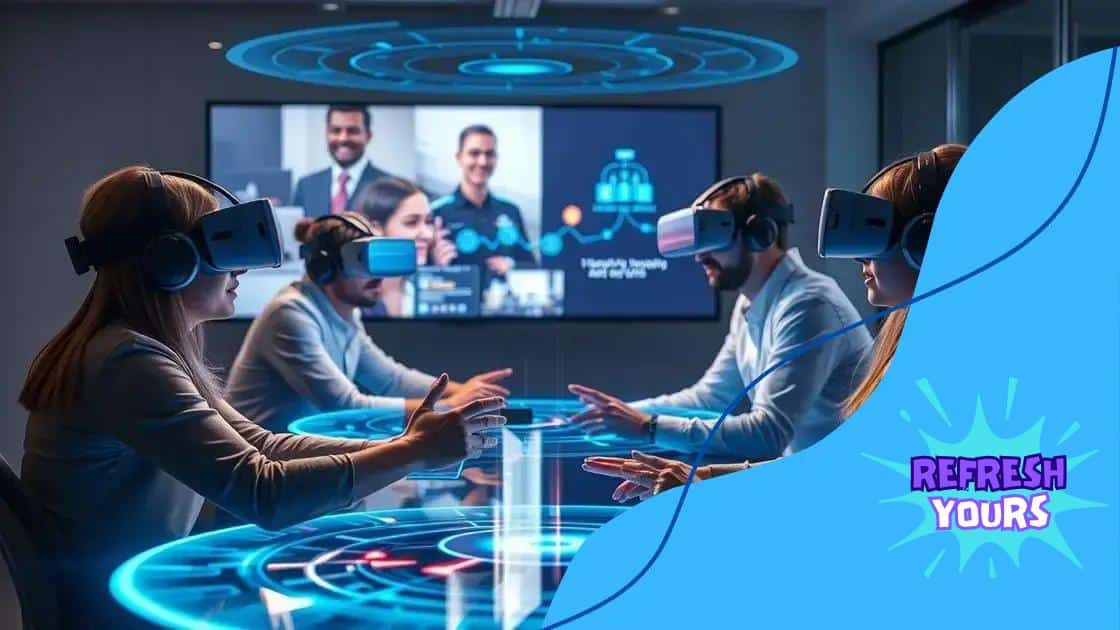How virtual reality is enhancing remote work experiences

Virtual reality is enhancing remote work experiences by creating immersive environments that boost engagement, collaboration, and productivity among remote teams, making virtual interactions more effective and enjoyable.
How virtual reality is enhancing remote work experiences is changing the way we connect with colleagues. Imagine stepping into a virtual office where collaboration feels almost face-to-face. This article delves into the exciting world of VR and its potential.
Understanding virtual reality for remote work
Understanding virtual reality for remote work is essential for grasping how this innovative technology transforms our work environments. Virtual reality (VR) creates immersive experiences that can revolutionize how teams interact, regardless of their physical locations.
In the realm of remote work, VR allows employees to step into a digital workspace that mimics the office. It offers a sense of presence, making team collaboration feel more natural and engaging.
What is Virtual Reality?
Virtual reality is a computer-generated simulation of a three-dimensional environment where users can interact using special equipment, such as VR headsets. This technology enables users to explore and communicate in a virtual space, providing a unique way to foster teamwork.
Key Features of VR in Remote Work
- Immersive Experiences: Users can engage with the environment through sight, sound, and sometimes touch.
- Real-time Collaboration: Teams can work together on tasks as if they were in the same room.
- Enhanced Communication: Non-verbal cues, like gestures and body language, can be conveyed, improving understanding.
These features create a more interactive and productive workflow, allowing remote teams to achieve their goals efficiently. By replacing traditional video calls with VR meetings, teams can foster stronger connections, leading to better collaboration.
Moving beyond meetings, VR can also be used for training and development. Employees can participate in simulations that prepare them for real-life challenges in their jobs. This hands-on experience is invaluable for skill-building.
Benefits of Using VR for Remote Work
As more companies embrace remote work, the benefits of virtual reality become increasingly apparent. Not only does it foster a sense of community among team members, but it also enhances motivation and productivity.
- Cost-effective: Virtual offices reduce the need for physical spaces, cutting down on overhead costs.
- Flexible Workspaces: Employees can choose environments that suit their working styles.
- Global Reach: Companies can hire the best talent, regardless of location.
Incorporating VR into remote work practices is an exciting prospect. As technology continues to grow, so does the potential for more dynamic and effective workflows.
Benefits of virtual reality in team collaboration
Benefits of virtual reality in team collaboration are numerous and can significantly enhance how teams work together. VR technology creates immersive environments that can help bridge the gap caused by distance, making team interactions feel more organic and engaging.
When teams use virtual reality, they can interact in ways that mimic face-to-face meetings. This fosters better connections and communication among team members.
Key Advantages of VR in Collaboration
Virtual reality offers unique benefits that can drastically improve team productivity and connection:
- Enhanced Engagement: Teams can work on projects together in the same virtual space, increasing focus and commitment.
- Visual Collaboration: VR allows for visual brainstorming sessions where ideas can be shared and manipulated in real-time.
- Improved Accessibility: Team members can join from anywhere in the world, making it easier to collaborate across time zones and locations.
This flexibility leads to more innovative solutions and ideas, as people from diverse backgrounds contribute their perspectives. The immersive nature of VR also encourages teamwork, as members often collaborate in a more relaxed environment.
Another significant advantage is the ability to conduct training and simulations within the virtual space. Team members can practice scenarios and role-play, which enhances their skills and prepares them for real-life challenges. This active participation boosts confidence and enhances team performance.
Building Stronger Connections
In a remote setting, building relationships can be challenging. Virtual reality enables teams to have social interactions in a virtual space, promoting bonding and a sense of community. Team-building activities can also be carried out in VR, making them more interactive and enjoyable.
As workers become more comfortable in this environment, they will likely find it easier to communicate openly and share ideas. This open communication encourages a culture of collaboration and innovation, benefiting the overall organization.
How virtual reality enhances engagement in meetings

How virtual reality enhances engagement in meetings is a game changer for remote teams. VR technology creates immersive experiences that significantly boost participation and interaction during meetings.
In traditional video calls, it’s easy for participants to zone out or multitask. However, with virtual reality, employees feel more present and involved. They can engage with their virtual surroundings and one another, leading to richer discussions.
Creating an Immersive Environment
Virtual reality offers a 360-degree environment that can be customized to fit different meeting purposes. Special features allow users to interact with various tools and content in real time. This immersion keeps attention focused, making discussions more effective.
Interactive Features that Boost Engagement
Some interactive features of VR meetings include:
- 3D Visualization: Participants can visualize complex data and concepts in three dimensions, leading to better understanding.
- Real-time Collaboration: Team members can work simultaneously on documents or projects while discussing, enhancing productivity.
- Virtual Breakout Rooms: Teams can form smaller groups for in-depth discussions, fostering deeper connections.
One of the key benefits of using VR in meetings is the ability to simulate real-life scenarios. Teams can engage in role-playing exercises or problem-solving tasks that require creativity and teamwork. This functionality not only makes meetings more enjoyable but also helps to solidify team bonding.
As team members engage with VR, they develop a sense of camaraderie. This shared experience can lead to increased trust and collaboration back in the physical workplace.
The Future of Meetings in Virtual Reality
As adoption increases, the potential for VR in enhancing engagement will continue to grow. Companies can leverage these tools to create memorable experiences that make meetings more impactful. The result is a workforce that feels more connected, even when physically apart.
Tools and platforms for virtual reality workspaces
Tools and platforms for virtual reality workspaces are essential for companies looking to implement VR solutions in their remote work strategies. These technologies enable teams to collaborate more effectively and enhance productivity, regardless of location.
With a variety of tools available, businesses can choose the ones that best meet their needs. Some platforms focus on creating immersive meeting environments, while others emphasize project collaboration.
Leading Virtual Reality Platforms
Several notable platforms have gained popularity for their features and capabilities:
- Spatial: This platform allows teams to create 3D virtual spaces for meetings and collaborations, making it easy to share ideas visually.
- AltspaceVR: Known for social gatherings and events, it also provides functional virtual workspaces where users can connect and collaborate.
- Rumii: A collaboration tool that offers virtual meeting rooms, whiteboarding capabilities, and file sharing to enhance teamwork.
These tools ensure that remote teams have the capability to communicate and collaborate as if they were in a physical office. By providing immersive experiences, they’re making team meetings more engaging and effective.
Each platform varying in design and functionality, allows for customized user experiences. It’s crucial for teams to explore and find the right fit that aligns with their goals and working styles. Users can participate in brainstorming sessions, real-time feedback exchanges, and hands-on workshops.
Choosing the Right VR Tool
When selecting a VR tool, consider the following aspects to ensure it meets your team’s needs:
- User-Friendliness: The platform should be easy to navigate, allowing all team members to participate without technical difficulties.
- Compatibility: Ensure that the tool works with existing hardware and software used by your team.
- Support and Resources: Look for platforms that offer training materials and customer support to help with onboarding.
Using the right tools can enhance virtual collaboration and create richer interactions. As virtual reality continues to evolve, being equipped with the right platforms will help teams stay ahead and work more effectively.
Future trends in virtual reality for remote work
Future trends in virtual reality for remote work are poised to reshape how teams interact and collaborate. As technology advances, we can expect significant changes that will enhance productivity and engagement in remote settings.
With the rise of virtual reality, companies are beginning to adopt more immersive tools that allow for deeper connections among remote employees. These trends signal a shift in how we view remote work.
Increased Adoption of VR Tools
As more companies recognize the benefits of VR, the adoption of these tools will likely increase. Virtual reality will become a common part of everyday business operations, leading to:
- Cost Reduction: Virtual environments will reduce the need for physical office spaces, leading to savings on overhead costs.
- Enhanced Collaboration: Teams will work together in simulated environments that foster creativity and connection.
- Improved Onboarding: New employees will experience more engaging training programs that prepare them for their roles effectively.
This trend toward increased adoption speaks to the value businesses see in virtual reality as a vital component of remote work.
Advancements in Technology
Technological advancements will lead to more sophisticated and user-friendly VR tools. Future virtual reality applications may include:
- Higher Quality Graphics: More realistic environments will enhance the immersion experience for users.
- Better Hardware: Lighter and more comfortable VR headsets will promote longer usage and comfort during meetings.
- AI Integration: Artificial intelligence could personalize user experiences, tailoring environments to individual preferences and enhancing collaboration.
As technology evolves, so will the possibilities for creating more impactful virtual interactions.
A Focus on Sustainability
Another trend involves a growing focus on sustainability. Companies will seek ways to reduce their carbon footprints, and VR can contribute by minimizing travel and promoting remote meetings. This shift can lead to a greener workplace while maintaining productivity.
Incorporating VR into remote work also offers opportunities for virtual team-building activities that emphasize environmental responsibility.
Diverse Applications of VR Beyond Meetings
Lastly, we will see an expansion of VR applications beyond meetings. Areas such as:
- Marketing and Sales: Businesses will utilize virtual reality for product demonstrations and marketing campaigns, allowing potential buyers to experience products fully.
- Healthcare: Medical professionals will employ VR for training simulations, improving skills and patient interactions without the risks associated with real-life practice.
- Education: Educational institutions will embrace VR to create immersive learning experiences that reach students across the globe.
The future of virtual reality in remote work looks promising. As trends continue to develop, companies that adapt to these changes will likely gain a competitive edge.
FAQ – Frequently Asked Questions about Virtual Reality in Remote Work
What are the benefits of using virtual reality for remote meetings?
Virtual reality enhances engagement and collaboration, making remote meetings more interactive and allowing participants to connect in immersive environments.
How can companies choose the right VR tools for their teams?
Companies should consider factors like user-friendliness, compatibility with existing technology, and the availability of support and training resources.
Will virtual reality replace traditional office environments?
While VR provides many advantages for remote work, it is likely to complement traditional office spaces rather than completely replace them, offering more flexible work options.
What future trends can we expect in virtual reality for remote work?
Future trends include increased adoption of VR tools, advancements in technology for better user experiences, and a focus on sustainability in remote work practices.





